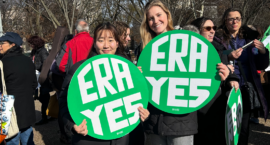
Abortion providers can challenge the Pennsylvania ban on Medicaid coverage for abortion as sex discrimination under the state’s Equal Rights Amendment and Equal Protection provisions of the Pennsylvania Constitution, according to the Pennsylvania Supreme Court. The decision overturned a 1985 case that said the ERA did not apply to abortion. The ban on Medicaid funding will now be reviewed as sex discrimination.
Two justices of the court explicitly stated that the Pennsylvania Constitution “secures the fundamental right to reproductive autonomy, which includes a right to decide whether to have an abortion or to carry a pregnancy to term. … Whether or not to give birth is likely the most personal and consequential decision imaginable in the human experience. Any self-determination is dependent on the right to make that decision.”











